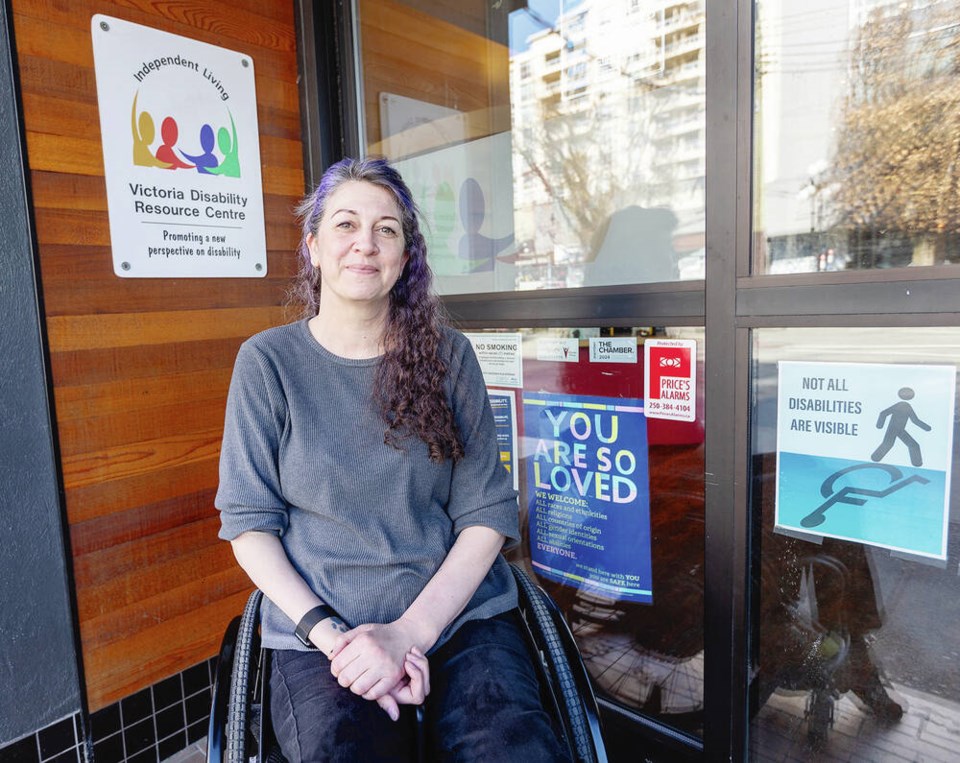Wendy Cox, who has used a wheelchair for the past 28 years, has given up counting the times someone would pat her head inappropriately. She has, however, learned how to move “really fast” whenever she sees someone reaching down to give her head a kiss.
Cox, the executive director of the Victoria Disability Resource Centre, said that while she has seen many positive changes in social attitudes over persons with a disability, there is still “a long way to go” to eliminate patronizing behaviours and actions, such as the head patting.
“In their defence, the action is always done with good intentions,” said Cox, who was 20 when she fell and broke her back. “Sometimes people are being overly nice, but their actions have the opposite effect.”
An example, she said, is when a passerby sees a person with vision impairment waiting at a crosswalk. The sighted person, thinking he is helping, will charitably take the elbow of the vision impaired individual and guide them across the road.
But the action may serve to confuse the vision-impaired individual, who may have been deciding which way to turn before proceeding.
“For a blind or partially sighted individual, the unwanted help undermines their self-esteem and sense of autonomy. What we would like to do is to make people mindful so that first ask if help is needed — and not make an assumption based on what they perceive,” she said.
It is difficult for the vision-impaired individual to confront the sighted individual immediately after the incident, because of a discrepancy in perspectives by both parties. One views the action as inappropriate, the other sees it as an act of charity (or chivalry).
Better communication is also necessary before different levels of government go ahead with projects.
She cites the yellow truncated domes recently being installed on some streets in the City of Victoria. The domes serve as a tactile warning for those who are blind or have vision difficulties by identifying the boundary between the sidewalk and the roadway. “Unfortunately, the width of domes makes it impossible to avoid if you are in a wheelchair. Some have reported difficulty going over them.”
As well as advocating for those with visible disabilities, the Victoria Disability Resource Centre also tries to raise awareness for the 75 per cent of their clients who have invisible disabilities. They include those with chronic pain, mental health issues, developmental impairments, COPD (chronic obstructive pulmonary disease), Crohn’s disease and others.
Every year the non-profit, which celebrates its 34th anniversary this year, fields 10,000 calls for help and support from the community.
Clients are assisted by eight full-time staff and a team of 35 volunteers, some as young as 15. Some of the volunteers are students enrolled in the Bachelor of Social Work program, who are required to complete two field education practicums toward their degree.
“We are a tight-knit group, probably because we are all empaths [a person who is attuned to the feelings and emotions of the people around them] and we all have a disability,” said Cox, who has been with the organization for 20 years.
Some have used their experience volunteering to secure jobs in the field while others have returned to serve on the board, which has a mandate that 51 per cent has to be persons with disabilities.
Roles that need to be filled include helping clients fill out federal and provincial disability assistance forms, with some forms taking up to three hours to complete.
While the work is rewarding, it can also be frustrating at times.
“The housing allowance is $500, but there are no places in Victoria with a $500 rent. So most people use their disability benefits for the balance. So it leaves them having to hit the food bank — or beg.”



